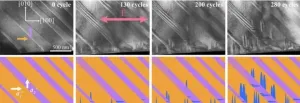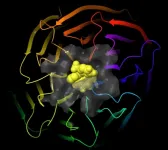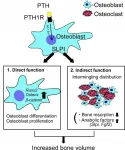Popeye with a whiff of rotten eggs
A sulfosugar from green vegetables promotes the growth of important gut bacteria
2021-04-09
(Press-News.org) Diet and the gut microbiome
With the consumption of a single type of vegetable such as spinach, hundreds of chemical components enter our digestive tract. There, they are further metabolized by the gut microbiome, a unique collection of hundreds of microbial species. The gut microbiome thus plays a major role in determining how nutrition affects our health. "So far, however, the metabolic capabilities of many of these microorganisms in the microbiome are still unknown. That means we don't know what substances they feed on and how they process them," explains Buck Hanson, lead author of the study and a microbiologist at the Center for Microbiology and Environmental Systems Science (CMESS) at the University of Vienna. "By exploring the microbial metabolism of the sulfosugar sulfoquinovose in the gut for the first time, we have shed some light into this black box," he adds. The study thus generates knowledge that is necessary to therapeutically target the interactions between nutrition and the microbiome in the future.
Sulfosugars from green plants and algae
Sulfoquinovose is a sulfonic acid derivative of glucose and is found as a chemical building block primarily in green vegetables such as spinach, lettuce, and in algae. From previous studies by the research group led by microbiologist David Schleheck at the University of Konstanz, it was known that other microorganisms can in principle use the sulfosugar as a nutrient. In their current study, the researchers from the Universities of Konstanz and Vienna used analyses of stool samples to determine how these processes specifically take place in the human intestine. "We have now been able to show that, unlike glucose, for example, which feeds a large number of microorganisms in the gut, sulfoquinovose stimulates the growth of very specific key organisms in the gut microbiome," says David Schleheck. These key organisms include the bacterium of the species Eubacterium rectale, which is one of the ten most common gut microbes in healthy people. "The E. rectale bacteria ferment sulfoquinovose via a metabolic pathway that we have only recently deciphered, producing, among other things, a sulfur compound, dihydroxypropane sulfonate or DHPS for short, which in turn serves as an energy source for other intestinal bacteria such as Bilophila wadsworthia. Bilophila wadsworthia ultimately produces hydrogen sulfide from DHPS via a metabolic pathway that was also only recently discovered," explains the microbiologist.
A question of dose: hydrogen sulfide in the intestine
Hydrogen sulfide is produced in the intestine by our own body cells as well as by specialized microorganisms and has a variety of effects on our body. "This gas is a Janus-faced metabolic product," explains Alexander Loy, head of the research group at the University of Vienna. "According to current knowledge, it can have a positive but also a negative effect on intestinal health." A decisive factor, he says, is the dose: in low amounts, hydrogen sulfide can have an anti-inflammatory effect on the intestinal mucosa, among other things. Increased hydrogen sulfide production by gut microbes, on the other hand, is associated with chronic inflammatory diseases and cancer. Until now, mainly sulfate and taurine, which are found in increased amounts in the intestine as a result of a diet rich in meat or fat, were known to be sources of hydrogen sulfide for microorganisms. The discovery that sulfoquinovose from green foods such as spinach and algae also contribute to the production of the gas in the gut therefore comes as a surprise.
"We have shown that we can use sulfoquinovose to promote the growth of very specific gut bacteria that are an important component of our gut microbiome. We now also know that these bacteria in turn produce the contradictory hydrogen sulfide from it," Loy sums up. Further studies by the scientists from Konstanz and Vienna will now clarify whether and how the intake of the plant-based sulfosugar can have a health-promoting effect. "It is also possible that sulfoquinovose could be used as a so-called prebiotic," adds Schleheck. Prebiotics are food ingredients or additives that are metabolized by specific microorganisms and used to explicitly support the intestinal microbiome.
INFORMATION:
Publication in ISME Journal:
Hanson BT, Kits KD, Löffler J, Burrichter A, Frommeyer B, Fiedler A, Denger K, Herbold CW, Rattei T, Karcher N, Segata N, Schleheck D, and Loy A. 2021. Sulfoquinovose is a select nutrient of prominent bacteria and source of hydrogen sulfide in the human gut. ISME Journal. DOI: 10.1038/s41396-021-00968-0
[Attachments] See images for this press release:

ELSE PRESS RELEASES FROM THIS DATE:
2021-04-09
Researchers at Lund University in Sweden have discovered that bird blood produces more heat in winter, when it is colder, than in autumn. The study is published in The FASEB Journal.
The secret lies in the energy factories of cells, the mitochondria. Mammals have no mitochondria in their red blood cells, but birds do, and according to the research team from Lund and Glasgow this means that the blood can function as a central heating system when it is cold.
"In winter, the mitochondria seem to prioritize producing more heat instead of more energy. The blood becomes a type of radiator that they can turn up when it gets colder", says Andreas Nord, researcher in evolutionary ecology at Lund University who led the study.
Until ...
2021-04-09
Ferroelectric materials are used in many devices, including memories, capacitors, actuators and sensors. These devices are commonly used in both consumer and industrial instruments, such as computers, medical ultrasound equipment and underwater sonars.
Over time, ferroelectric materials are subjected to repeated mechanical and electrical loading, leading to a progressive decrease in their functionality, ultimately resulting in failure. This process is referred to as 'ferroelectric fatigue'.
It is a main cause of the failure of a range of electronic devices, with discarded electronics a leading contributor to e-waste. Globally, tens of millions of tonnes of failed electronic devices go to landfill every year.
Using advanced ...
2021-04-09
During the acute phase of the COVID-19 pandemic, emergency department doctors, nurses and other frontline staff experienced unprecedented levels of stress and emotional exhaustion that included nightmares or insomnia, according to a UC San Francisco-led study of emergency departments across the country.
The study, among the first to assess mental health effects of the pandemic at a geographically diverse sample of emergency rooms, found that nearly one-fifth of the ER staff were at elevated risk for post-traumatic stress disorder (PTSD).
The study also reported that regular testing for COVID-19 helped to reduce stress among emergency personnel, particularly for those with previous positive antibody ...
2021-04-09
COLUMBUS, Ohio - In some men, having traditional masculine characteristics such as competitiveness and adventurousness was linked to being better fathers to infants, a new study found.
But the men in this study - highly educated and from dual-earner couples - combined those stereotypically masculine traits with the belief that they should be nurturing, highly involved fathers.
The researchers were surprised that traits often seen as old-fashioned male stereotypes were linked to more positive parenting behaviors, said study lead author Sarah Schoppe-Sullivan, professor of psychology at The Ohio State University.
It ...
2021-04-09
An international research team led by Monash University has uncovered a new technique that could speed up recovery from bone replacements by altering the shape and nucleus of individual stem cells.
The research collaboration involving Monash University, the Melbourne Centre for Nanofabrication, CSIRO, the Max Planck Institute for Medical Research and the Swiss Federal Institute of Technology in Lausanne, developed micropillar arrays using UV nanoimprint lithography that essentially 'trick' the cells to become bone.
Nanoimprint lithography allows for the creation of microscale patterns with low cost, high ...
2021-04-09
The concentration of the radioactive element radon is known to change in the ground before and after earthquakes. Previous studies have shown elevated radon levels in the atmosphere before the mainshock of a large inland earthquake due to foreshock activity and slow slip.
But now, researchers from Tohoku University have revealed an anomaly in this phenomenon. Through the analysis of data before and after the 2018 Northern Osaka Earthquake, they discovered that the atmospheric radon concentration decreased.
The results of their research were published online in Scientific Reports on April 2, 2021.
"For the first time, we found a decrease in the atmospheric radon associated with seismic quiescence before the mainshock of ...
2021-04-09
A team from the Department of Agronomy at the UCO has demonstrated, through field tests carried out during 8 agricultural seasons, that foliar feeding with fertilizer increases the concentration of zinc in wheat more than if it is applied to the soil
Micronutrient deficiencies pose health problems for a third of the world's population. Worldwide, zinc deficits are more problematic in the rural areas of developing countries, where diets are largely limited to vegetable products grown in soils suffering from low nutrient availability. Biofortification, the process of bolstering the nutritional value of crops by increasing ...
2021-04-09
Researchers at the Obesity Research Unit of the University of Helsinki have found that obesity clearly reduces mitochondrial gene expression in fat tissue, or adipose tissue. Mitochondria are important cellular powerplants which process all of our energy intake. If the pathways associated with breaking down nutrients are lazy, the changes can often have health-related consequences.
A total of 49 pairs of identical twins discordant for body weight participated in the study conducted at the University of Helsinki: their body composition and metabolism were studied in detail, and biopsies from adipose and muscle tissue were collected. Multiple techniques for ...
2021-04-09
WASHINGTON, April 9, 2021 -- For the millions of people worldwide who have sickle cell disease, there are only a few treatment options, which include risky bone marrow transplants, gene therapy or other treatments that address a subset of symptoms. Today, researchers will describe the discovery of a small molecule with the potential to address the root cause of sickle cell disease by boosting levels of fetal hemoglobin, a healthy form that adults normally do not make. The drug could be formulated into a convenient daily tablet.
The researchers will present their results today at the spring meeting of the American Chemical Society (ACS). ACS Spring 2021 is being held online April 5-30. Live sessions will be hosted April 5-16, and on-demand and networking content will continue through ...
2021-04-09
Osaka, Japan - Despite what some people think, bone is not merely a passive component of the body. The skeleton is structurally dynamic and responds to life's physical stresses with continual equilibration between bone mass loss and reformation. This ensures healing and remodeling in tune with the ebb and flow of calcium and phosphorus in the bloodstream. Now, researchers at Osaka university have identified a molecule--secretory leukocyte protease inhibitor (SLPI)--that helps mediate this critical balance, which could be used in the development of new treatments for bone diseases such as osteoporosis.
Skeletal tissue changes are orchestrated ...
LAST 30 PRESS RELEASES:
[Press-News.org] Popeye with a whiff of rotten eggs
A sulfosugar from green vegetables promotes the growth of important gut bacteria





